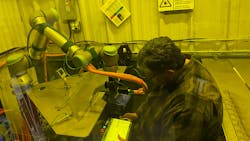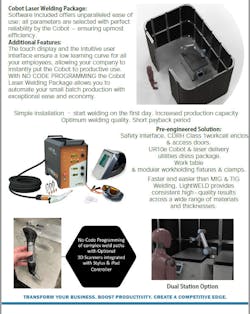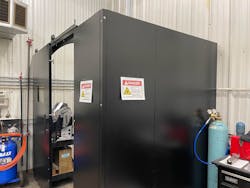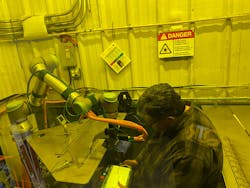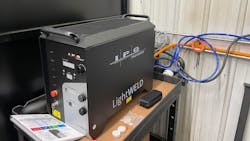Q&A: The Case for a Pre-engineered Laser Welding Cobot Cell
Manufacturers looking for ways to rearchitect their welding solutions may find their needs can be met with a pre-engineered solution.
At the very least, readymade options take the guesswork out of what to automate first or how to integrate the robot with the machine. They also have built-in safety features and efficiency, often require less space than industrial robots, are four to five times faster than manual welding, and eliminate rework and scrap parts.
“Automation by definition delivers a controlled and repeatable process, and [cobot welding systems] are four to five times faster than manual welding,” explained Brian Knopp, founder of Cobot Systems, which focuses on automated manufacturing, including laser welding, CNC machine tending, screw driving, dispensing and assembly.
Hardly a newcomer to laser welding, Knopp and his partner, Brian Miller, started their first automation company, ProCobots, in 2018, which had an exclusive focus on CNC machine tending. The pair sold the company to Indianapolis-based Hurco in 2019, and moved on to develop the first commercially available IPG LightWELD laser welder to be guided and controlled by a cobot.
Knopp and Miller hitched their integration expertise to the cobot capabilities offered by Universal Robots when they launched Cobot Systems in 2021. A 90-min. online training course is all it takes to bring the operator online, Knopp said.
“Laser welding enables dramatically faster welding, is easier to learn and operate, and provides higher-quality and consistent results across a wider range of materials and thicknesses with minimal distortion, deformation, undercut or burn-through,” he said in a recent Universal Robots press release.
In the following Q&A with Machine Design, Knopp shares a few basic considerations for pre-engineered welding solutions and discusses how his company’s collaborative laser welding cell stacks up.
Machine Design: Please walk us through the components and features of your welding cell.
Brian Knopp: Our pre-engineered welding package is a laser welding system built around the Universal Robots UR10e collaborative robot and the IPG LightWELD handheld laser. We have a standardized welding table designed with integral robot mounting brackets, storage for the UR controller and, most importantly, mechanical and pneumatic fixturing. We have designed an EOAT (end-of-arm tooling) system to mount the welder to the cobot and developed a URCaps software application that enables the robot program to dynamically set and adjust welding parameters and select between spot welds and path welds. The system also includes an enclosure with safety interlocks.
MD: Each type of automation has its own best applications. How do cobot welding systems stack up to fixed automation?
BK: Our robotic laser welding system utilizes the IPG handheld laser welder. The IPG LightWELD is four times faster than traditional TIG welding, which makes it difficult for a human operator to control. By integrating the handheld laser with the cobot, companies can take advantage of the higher speeds and maximize quality through the precision positioning capabilities of the cobot.
MD: What are the best applications for this robotic welding system? Can you give examples of tasks that this welding system can handle better than traditional welding methods?
BK: Best applications are stainless and carbon steel sheet metal welding. Traditional TIG welding can burn through thin sheet metal and cause significant distortion and discoloration. Cobot laser welding does not introduce as much heat to the materiaL, allowing welding of very thin materials without burn through or distortion. This is a game-changer.
MD: What floor footprint is needed to set up this welding cell?
BK: The smallest cell we offer requires a 6 ft. × 8 ft. footprint.
MD: What kind of payback or productivity gains can be expected from a cobot welding system?
BK: ROI can be achieved in as little as six months. We have customers that have reduced a 90-min. TIG welding application down to six minutes using our laser welding cobot cell.
MD: Why should one consider laser welding over traditional arc welding?
BK: Laser welding is recommended as a replacement to TIG welding because it is four to five times faster than TIG, eliminates distortion and it works great on materials up to ¼ in. thick. Traditional arc welding works on much thicker materials and are better suited for welding structural steel such as angle iron, channel and thick-walled pipe.
MD: Is it important to be able to track weld quality while the part is still in production? What happens if a gap or imperfection is detected?
BK: Absolutely. For the most part, laser welding does not use filler metal. It is a fusion weld and requires tight seams and accurate joints. Sheet metal parts processed on CNC laser cutting machines and CNC press brakes produce joints that are well suited for laser welding. If there is a gap or imperfection on the joint, a wire feed attachment can be added to the laser welder.
MD: How should one start to select a welding robot for the application?
BK: If you want to automate a TIG welding process, contact us at www.cobot.systems. For automation of MIG and Arc welding, I suggest contacting your local Universal Robots distributor and/or local welding equipment dealer.
MD: How does automation impact welding safety?
BK: All automation projects require a risk assessment, which results in proper safety requirements being built into the system.
MD: How is the job of the traditional welder in a job shop impacted by automated welding systems?
BK: Traditional welders can focus on projects requiring their skills versus running production.
MD: When you speak to customers in the field, where are they on their automation journey? Are they ready for a welding cobot or does it take convincing to make the transition?
BK: With today’s labor challenges it does not take much convincing. Customers know automation is a solution and know they want it. The difficulty for them is finding the right partner.
About the Author

Rehana Begg
Editor-in-Chief, Machine Design
As Machine Design’s content lead, Rehana Begg is tasked with elevating the voice of the design and multi-disciplinary engineer in the face of digital transformation and engineering innovation. Begg has more than 24 years of editorial experience and has spent the past decade in the trenches of industrial manufacturing, focusing on new technologies, manufacturing innovation and business. Her B2B career has taken her from corporate boardrooms to plant floors and underground mining stopes, covering everything from automation & IIoT, robotics, mechanical design and additive manufacturing to plant operations, maintenance, reliability and continuous improvement. Begg holds an MBA, a Master of Journalism degree, and a BA (Hons.) in Political Science. She is committed to lifelong learning and feeds her passion for innovation in publishing, transparent science and clear communication by attending relevant conferences and seminars/workshops.
Follow Rehana Begg via the following social media handles:
X: @rehanabegg
LinkedIn: @rehanabegg and @MachineDesign
